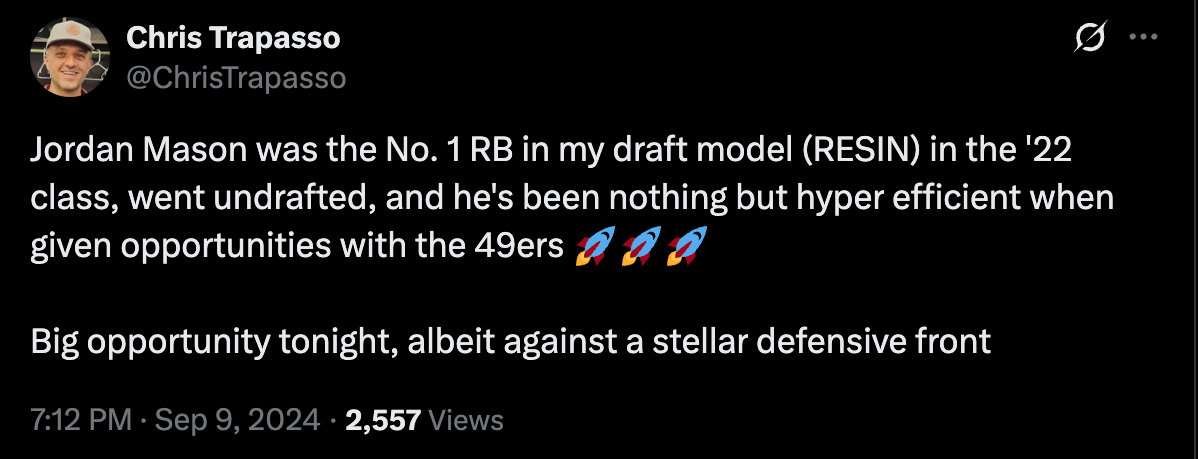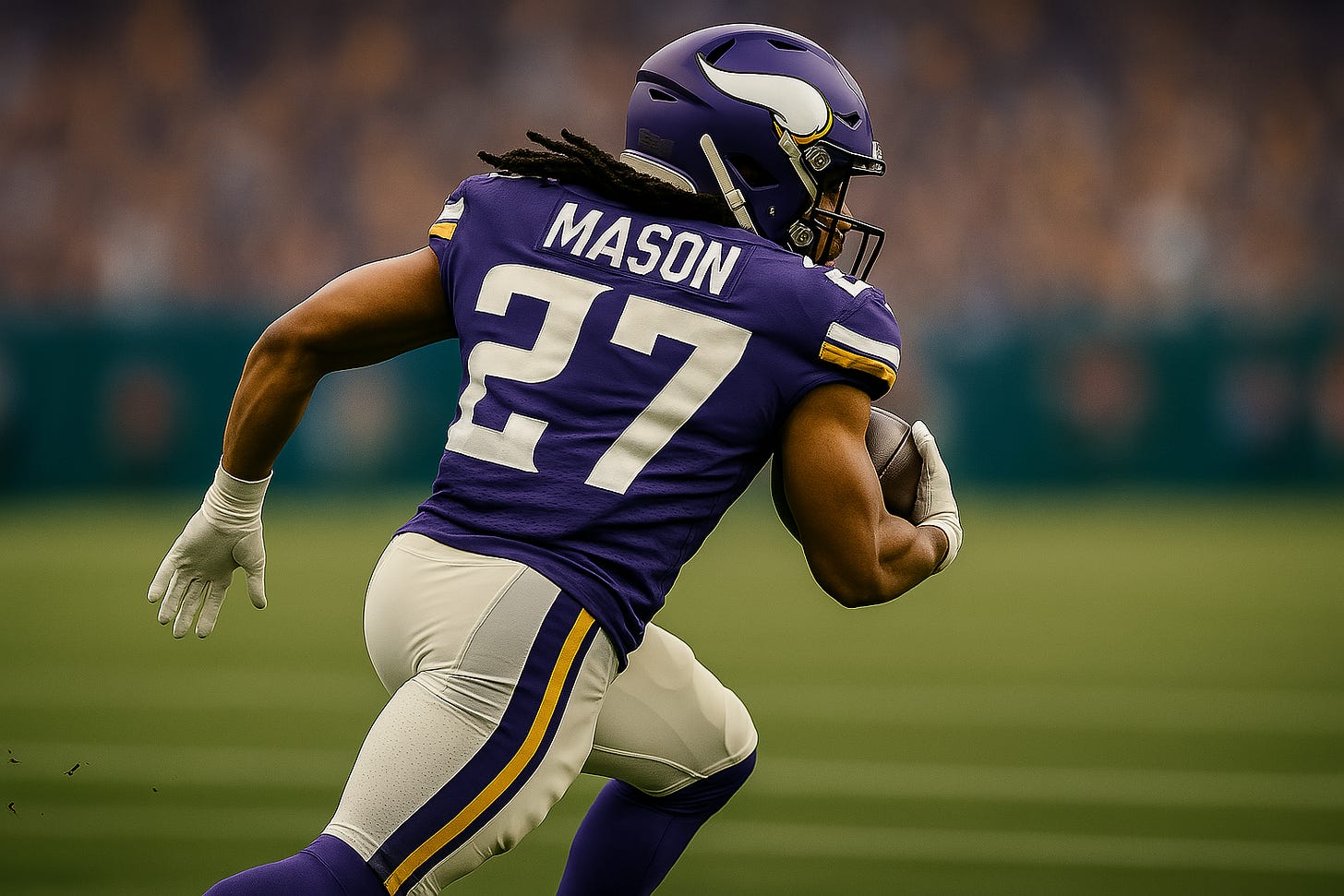Jordan Mason is the next god on the ground for the Vikings
From diamond-in-the-rough UDFA in San Fran to star in Minnesota
My analytical adoration for Jordan Mason began on accident.
During every NFL Draft cycle, my main mission is to watch and evaluate as many prospects as possible — and I’ve usually been able to churn out around 250 - 300 scouting reports for each of the past eight draft classes.
In 2022, Mason was not one of them. He slipped through the cracks. For me, and the NFL. He went undrafted that year. There were 22 running backs picked. Mason signed with the 49ers during the priority free-agent firestorm that officially begins the second Mr. Irrelevant is announced.
Ironically it was that summer of 2022, in somewhat of my own frenzy, I built my predictive NFL Draft algorithm, which I named Reverse Engineered Scouting Index Number, or what I almost always refer to as RESIN.
(And, yes, I’ll be citing RESIN often during the 2026 draft cycle and will absolutely provide detailed and TL;DR explainers beforehand )
For now, and for the sake of this article, all you need to know is that RESIN only uses college data and pre-draft athleticism to give each prospect a number.
After running RESIN on every drafted positional player (outside of OLs), I tested a variety of UDFAs and found that, generally speaking, the quality ones had higher RESINs than those who failed to cut it in the league and sometimes had higher (or comparable) RESINs than early-to-mid-round flops. Gus Edwards and Sony Michel having very similar RESINs served as one of the prime examples of the algorithm’s power.
Fast forward to mid-December, after months of soaking in everything NFL from August until what was then Week 15 — and keeping continual tabs on RESIN as another year unfolded on the field.
It was that week that I saw a highlight of No. 24 on the 49ers ripping off a long, 50-plus yard run to ice the game — and the NFC West — for San Francisco.
“Who the hell was that?” Probably just more miracle work from Kyle Shanahan, generating run-game efficiency out of thin air, I thought.
Before that game, Mason had toted the rock 29 times as a rookie, and was distinctly behind newly acquired superstar Christian McCaffrey, Jeff Wilson, and Elijah Mitchell. At that point, calling him an afterthought would’ve been generous.
After that season — sparked by the impact that 56-yard run had on my memory — I ran him through the RB RESIN system and was so floored with his results, I triple-checked the inputs.
Mason’s 21.74 RB RESIN was, at the time, the third-highest in my five-year database, only outdone by 2021 first-rounder Travis Etienne and Javonte Williams.
He instantly became the archetype for one of the main features I was aiming to accomplish with RESIN — the identification of late-round picks or UDFA with plus contributor or star potential. Or at least, if I was to believe in RESIN, I felt compelled to tout him as a back deserving of more opportunity, UDFA draft status be damned.
Unfortunately for Mason, he saw fewer carries in Year 2 than his rookie season (40 vs. 43) but was simmering as a potential high-efficiency stud. He had taken those 83 NFL carries and accumulated 464 yards (5.59 yards per), with a respectable missed tackle forced rate of 21.6% — which is right around where the game’s elite, high-volume backs hover — and had a very hefty yards-after-contact-per-rush figure of 3.68.
I continued to pound the table, which, when you’re in my position, really just means tweet and write about a player, and I certainly did those things regarding Mason. I picked him for my ‘Out of Nowhere’ Breakout Team in late July 2023. I also sent the below tweet before the 49ers’ 2024 season-opener, with Mason in line for feature-back duties because of Christian McCaffrey’s calf/Achilles injury:
I even added three rocket ship emojis for what I hoped would be added impact:
Against said stellar defensive front — the Jets’ — Mason erupted for 147 yards on 28 carries with one touchdown in a 49ers rout of Gang Green.
As San Francisco’s clear No. 1 back, Mason was fifth in the NFL in rushing through seven weeks (771 yards) with a comparable MTF % to that of his former Georgia Tech backfield mate Jahmyr Gibbs.
Mason’s was 25.1%, Gibbs’ was 27.6%.
Mason also achieved all these figures despite having the NFL’s second-highest stacked-box rate (33.3%) according to Next Gen Stats. [insert mind-blown emoji here]
Two weeks later, McCaffrey returned and, of course, reassumed top-back duties on a reeling 49ers club. From Weeks 8-11, Mason received a grand total of 12 carries.
Ironically, both McCaffrey and Mason went down with leg injuries in the same, snow-globe game in Orchard Park on Sunday Night Football in a blowout loss to the Bills in early December. He was placed on IR the next day, ending his legitimate breakout season.
In March, Vikings GM Kwesi Adofo-Mensah swung a deal with the 49ers, sending a 2025 sixth-rounder and a 2026 fifth-rounder to acquire Mason and a 2025 sixth-rounder. I could not have loved the transaction any more.
No, I don’t think teams should draft running backs in the first round, nor do I believe it’s in the best interest of essentially every team to give a runner an exorbitant second contract.
With this move, Adofo-Mensah tapped into a rarely utilized market — acquiring a young, proven, low-mileage runner for a late-round pick. So smart.
Nothing against Aaron Jones — I had a mini draft crush on him in 2017 coming out of UTEP but never envisioned him being as damn good as he’s been in the NFL.
But check the age and carry disparity between these two backs. Just counting professional runs, Jones has 1,549 attempts to his name. And he’s 31 in December.
Mason has carried the football 238 times in the NFL and turned 26 in May. If we count collegiate totes too — Jones’ figure swells to 2,207, Mason’s just 687.
(plus, in my new running back statistic, ATEX, which measures tackle-avoidance + explosive plays, Jones’ 2024 was below-average despite the fact he went over 1,000 yards)
The kicker to all this — Mason’s spent the past three years learning the intricacies of running in a Shanahanian system, which is precisely what he’ll be deployed in with the Vikings under Kevin O’Connell.
Minnesota has a high-caliber offensive line. Justin Jefferson is the game’s best receiver. Jordan Addison is a damn good No. 2. The coaching staff will likely not overload J.J. McCarthy’s plate. The defense will be damn good — all the ingredients are there for this prediction.
Mason isn’t going to be Adrian Peterson. No one is Adrian Peterson besides Adrian Peterson. But Minnesota has been desperately searching for their next ground-game workhorse since the decline of Dalvin Cook.
And they have him in Mason, a former UDFA with a high RESIN.







